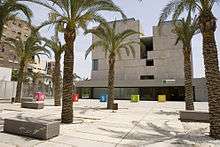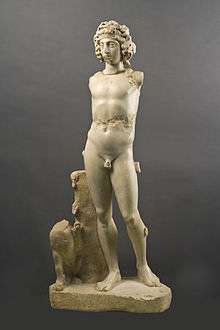Museum of Almería
| Museo Arqueológico de Almería | |
 | |
 Location of Museum of Almería in Almería city | |
| Established | 1934; in present location since 2006 |
|---|---|
| Location |
91, Carretera de Ronda, 04005 Almería, Andalusia, Spain |
| Coordinates | 36°50′18″N 2°27′20″W / 36.838333°N 2.455417°W |
| Type | Archaeological Museum |
| Visitors | 55.617 (2012)[1] |
| Director | Arturo del Pino Ruiz |
| Website | |


The Museum of Almería is one of the most important museums in the Almerian province and maintains the largest collection of archaeological remains in Almería. The Museum is situated in Almería (Andalusia, Spain), Carretera de Ronda Street, 91. In 2006 the museum moved to a new building designed by Ignacio García Pedrosa y Ángela García de Paredes. The building won two awards (PAD and ARCO) in 2004. This building was also finalist in 2005 in the Fostering Arts and Design (FAD) Awards and it in 2008 an honorable mention by the European Museum of the Year contest which took place in the European Museum Forum. The museum has been a public institution since 1934, marking its 80th anniversary in 2014.
History of the institution
The first attempt at the creation of the Museum of Almería dates back to the 19th century. In 1880 the Belgian engineer Luis Siret found the most famous prehistoric site in this region. Due to his archaeological researches, he developed a significant collection of ancient pieces which he finally donated to the National Archeological Museum, with the desire that one part of the collection stays in Almería. The conditions were agreed during the Second Spanish Republic when the archeological museum was opened. There were two small rooms which were handed over by the “Escuela de Artes y Oficios” in 1934 but this collection didn’t have the pieces that Louis Siret had hoped would remain in Almería. After a lot of difficulties which took place throughout the years, 2006 was the year that the museum finally settled into its new place.[2]
Current museum
The new museum has three floors in which the museum collections are distributed. The backbone running up though all the floors is a huge stratigraphic column that goes up almost to the roof of the building. The exhibition is mainly dedicated to recent Copper and Bronze Neolithic Age history.
 Hall, with "Siret Cloud". Museum of Almería.
Hall, with "Siret Cloud". Museum of Almería. Model on archaeological methodology.
Model on archaeological methodology. Stratigraphic column.
Stratigraphic column.- Assembly hall of the Museum of Almería.
 Outside of the "Circle of Life" (Prehistoric Society Los Millares).
Outside of the "Circle of Life" (Prehistoric Society Los Millares). Inside of the "Circle of Life" (Prehistoric Society Los Millares).
Inside of the "Circle of Life" (Prehistoric Society Los Millares). "Circle of Death" (Prehistoric Society Los Millares).
"Circle of Death" (Prehistoric Society Los Millares). Gallery devoted to prehistoric Society El Argar (2nd Floor).
Gallery devoted to prehistoric Society El Argar (2nd Floor). The Model prehistoric Society El Argar.
The Model prehistoric Society El Argar. Roman Society in Southeast Hispania (3rd floor).
Roman Society in Southeast Hispania (3rd floor).- Roman Society in Southeast Hispania. Trade in natural resources.
 Al-Andalus (3rd floor).
Al-Andalus (3rd floor). Cemeteries in Al-Andalus (3rd floor).
Cemeteries in Al-Andalus (3rd floor). Foundation of Almería (Al-Marilla).
Foundation of Almería (Al-Marilla).
Collections
Permanent exhibition
The permanent exhibition is located on the first and second floors of the building and they focus mainly on the hunters' and foragers' society, the society of the “Millares,” specifically from Santa Fe de Mondújar, Almería and the society of “El Argar” of Antas, Almería. On the second floor, is a metal structure in the middle of the room called the “Circle of Life.” Surrounding it can be found materials that teach us about trade and war of the Millares society. There are also objects related to the daily life of the settlement. The “The Circle of Death” display, with the support of a video projection, shadows and sound, demonstrates much about the collective use of the graves and the ritual sequence carried out with each new burial. On the second floor is an interesting layout of consecutive walls progressing from the bottom to the top, with the intention of showing how the society lived on the hillsides through their terraced homes and landscapes, especially in Fuente-Álamo, Cuevas del Almanzora, Almería. The area includes small sub-rooms with glass cases containing big vessels, bronze weapons, silver and gold objects and ceramics among other remains.[3]
Semi-permanent exhibition
On the third floor can be found a long term display which currently has a large collection of Roman and Andalusian pieces. Of note is the beautiful sculpture which is installed on a large fragment of mosaic. This is the god Bacchus, found in a Roman villa excavated in the town of Chirivel, in the northern part of Almería. In this room can also be found other objects related to the large Roman influence in the Iberian Peninsula, specifically in Almería. One can also appreciate here some Andalusian art which is represented by a large collection of Muslim tombstones, of which Almería was the leading production center. The big cube that occupies the center of the room holds cabinets inside which are dedicated to the caliphate and hold ceramics, toys, coins, and the like.[4]
More in the museum
The museum also holds a library which is open to researchers the general public. The books can be consulted in the library. It has the same hours as the museum, although only from Monday to Friday. There is an educational classroom where the “Friends of the Museum” hold their meetings and other activities take place. The museum holds a large exhibition area on the main floor where other displays of painting, contemporary art, photography, and other topics are displayed. Exhibitions are usually held for one to two months. Finally, there is a large space at the front of the museum which can be used by the general public to put on theater, meetings, cinema, presentations, and other activities. Currently, they have free weekly cinema.
Gallery
 Prehistoric Idol cruciform (Cantoria, Almería, Spain).
Prehistoric Idol cruciform (Cantoria, Almería, Spain). Prehistoric Idol alabaster (Rioja, Almería, Spain).
Prehistoric Idol alabaster (Rioja, Almería, Spain). Flint arrowhead (Prehistoric Society of Los Millares. 3200-2250 BCE).
Flint arrowhead (Prehistoric Society of Los Millares. 3200-2250 BCE). DNecklace consisting of 59 shells. Dated to the Middle Neolithic (Vera, Almería, Spain).
DNecklace consisting of 59 shells. Dated to the Middle Neolithic (Vera, Almería, Spain). Ivory comb found in the archaeological site of El Chuche (Benahadux, Almería). Dated between the 4th and 2nd centuries BCE.
Ivory comb found in the archaeological site of El Chuche (Benahadux, Almería). Dated between the 4th and 2nd centuries BCE. Bowl from a tomb in the necropolis of Los Millares (Almería), one set of the most important Copper Age in Western Europe.
Bowl from a tomb in the necropolis of Los Millares (Almería), one set of the most important Copper Age in Western Europe.- Bone Amulet Pendant. Prehistoric Society of Los Millares. 3200-2250 BCE (Santa Fe de Mondujar, Almería, Spain).
 Idol oculado bone shaped horn (Prehistoric Society of Los Millares. 3200-2250 BCE).
Idol oculado bone shaped horn (Prehistoric Society of Los Millares. 3200-2250 BCE). Argárica Ceramic Cup. Found in El Ejido (Almería), comes from a burial. Bronze Age (1700-1300 BCE).
Argárica Ceramic Cup. Found in El Ejido (Almería), comes from a burial. Bronze Age (1700-1300 BCE). Gold bracelet. Prehistoric Society of El Argar (2250-1550 BCE).
Gold bracelet. Prehistoric Society of El Argar (2250-1550 BCE). Tulepa burnished argárica (Bronze Age, 2250-1550 BCE).
Tulepa burnished argárica (Bronze Age, 2250-1550 BCE). Roman Lucerne (206 BCE - 409).
Roman Lucerne (206 BCE - 409). Bronze ring with agate (located in Villaricos, Almería). Romanization (206 BCE - 409).
Bronze ring with agate (located in Villaricos, Almería). Romanization (206 BCE - 409). Fragment of a male sculpture in white marble for the left foot. High Roman Empire (Villaricos, Almería).
Fragment of a male sculpture in white marble for the left foot. High Roman Empire (Villaricos, Almería). Bas-relief in marble, unique in Spain and in the Islamic West to represent human figures, Al-Andalus (11th century).
Bas-relief in marble, unique in Spain and in the Islamic West to represent human figures, Al-Andalus (11th century). Toys paste by hand. Found Bayyana (Pechina, Almería). Al-Andalus (885-915).
Toys paste by hand. Found Bayyana (Pechina, Almería). Al-Andalus (885-915). Almahade clay jar (Almería, 1157-1238).
Almahade clay jar (Almería, 1157-1238).
References
- ↑ "Estadística de museos públicos de Andalucía" (PDF). Unidad Estadística y Cartográfica. 13 May 2013. Retrieved 8 February 2014. Check date values in:
|year= / |date= mismatch(help) - ↑ López Rodríguez, José Ramón. Historia de los museos en Andalucía: 1500-2000. -- Sevilla: Universidad de Sevilla, 2010.
- ↑ Ramos Lizana, Manuel. Museo de Almería: guía oficial. -- Sevilla: Junta de Andalucía, Consejería de Educación, Cultura y Deporte, 2014.
- ↑ Ramos Lizana, Manuel [et. al.]. Museo de Almería: guía breve. -- Sevilla: Consejería de Cultura, 2009.
External links
| Wikimedia Commons has media related to Museo de Almería. |
- Official website
- Digital Collections Network of Museums of Spain. Advanced Search
- The museum brochure
- Brochure and game the Museum of Almería for children
- Architecture of state museums. Spain
- Pictures and technical details Almería Museum. GPD Project
- Spain is culture. Museum of Almería
- Official Guide museums of Andalusia. 2010